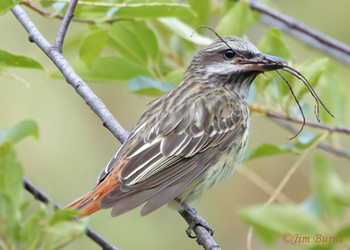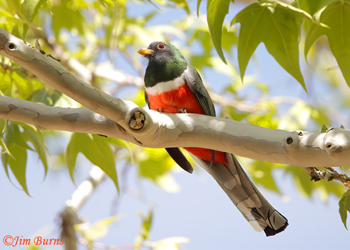Teaser alert, the reason for this will be provided in this column’s final paragraph, but first a story about how Covid-19 has brought out both the best and the worst in the nature of our species and, though somewhat loathe to admit it, at times I feel for me personally it has done the latter. There is a slice of my personality somewhat aligned with that of Rat, the protagonist in the Pearls before Swine comic strip, who would be perfectly happy to pass through this life avoiding all intersections with other people.
The story begins last month in a wilderness area of southern Arizona. In springtime two of Arizona’s most iconic and sought after bird species vie with one another for nesting cavities. Both have the same habitat preference and both are often heard without being seen because of their distinctive but totally different calls. I am on this adventure, not because of any precise directions to a specific site on any of the birding hotlines, but because I am trying to braid together disparate strands of rumors I’ve heard on the birding grapevine.
Here’s the thread--from the last parking area on the mountain, follow a path which used to be an old road until it tops out into a flat area where you will see a side trail which drops down into the creek bed. There must be at least a hundred places on this mountain which fit this description, and is it a creek if there is no running water? There is said to be a hole in a huge old Sycamore on the far side of the creek. A male and female of one species have been seen investigating the cavity, and two birds of the other species have been seen gathering nesting material nearby.
I glance at my watch as I arrive at a possible site, actually the third such site which perhaps fits the description, since I left the trailhead early this morning. It is 12:30 pm. Not the best time of day for nesting pairs to be out and about but, on the other hand, not a likely time to encounter hikers and other birders on this popular route. As if anyone would even take this side trail going nowhere except to this dry creek bed. So, I decide for the third time today, I will loiter unobtrusively in this candidate area, hoping to see birds but no people.
I am not dressed in camouflage but in my usual birding/photography “uniform,” dull, dark colors that blend in well with the rocks and trees of the sun dappled canyon. I cross the creek bed, gain a few feet of elevation, sit down on a log in the shade, and watch the presumed nest cavity in the Sycamore. For three hours. Save for the occasional chatter of the ubiquitous Acorn Woodpeckers, not a bird is vocalizing. Neither bird of the two target species comes or goes from the cavity. Nothing.
Just as I nod off I hear voices. A couple with a young daughter turn onto the side trail, obviously hikers but not birders by the absence of binoculars or camera, and come toward me, talking, laughing, just enjoying the day. They have not yet noticed me. Disgruntled at my apparently wild goose chase, I rouse myself and slink quietly behind a tree. They glance around, confer about the spur trail’s “dead end,” then turn and leave without seeing me. Inwardly I chastise myself for my lack of sociability.
I look for another spot with a better sun angle for photos. Surely, even if the female of either species is incubating she will soon emerge to forage or be called out by her mate. Wary now of any human intrusion after so many fruitless hours of watching, and having once avoided obvious human interaction, I decide I will intentionally abandon my own species. I hunker down behind a huge boulder completely out of sight from either the main trail or the spur. The vigil continues.
Half an hour passes before I hear voices again. I peer out from behind the rock. Two birders, men with binoculars, pause halfway down the spur trail glassing the sycamore, and discuss the possibility they have “finally found the nesting cavity” of their target bird. I could pop out and apprise them of my futility, but it’s hot, it’s late, and they will surely give up and leave me to my solitary surveillance. I hunker back down, and they soon give up and leave.
None of the target birds appeared the rest of the afternoon, so I can report the grapevine traffics only in rumors. Arriving at the same site at the crack of dawn the next morning, I had a male of one of the species hanging around and vocalizing frequently, and the pair of the other species was gathering twigs nearby but heading down canyon with the nesting material. None of the four birds entered, left, or investigated said cavity, and I never even saw the second female. Oh, and I can report I didn’t see a single mask all day either.
The pandemic rages on. Here’s why. I recently spoke with a biologist friend who told me she was not going to the annual professional meeting of her group in Colombia, South America this summer, and I assumed it was because of Covid concerns. No, she couldn’t afford the trip and, besides she said, over 90% of Colombians have received at least one vaccine dose. Why, I wondered aloud, would a country presumed to be “third world” be so far ahead of the U.S. in vaccine compliance?
My friend’s answer, given quickly and matter-of-factly, stunned and saddened me as I realized both its simplicity and its validity. “People in other countries care about one another” she said. In light of my behavior during my recent adventure, you may think I should issue a mea culpa because, like Rat, I consciously avoided proximity with my fellow nature lovers, but let me remind you I saw not a single mask and report I am fully vaccinated and twice boosted.
Sulphur-bellied Flycatcher with nesting material |
Elegant Trogon male in Sycamore |

